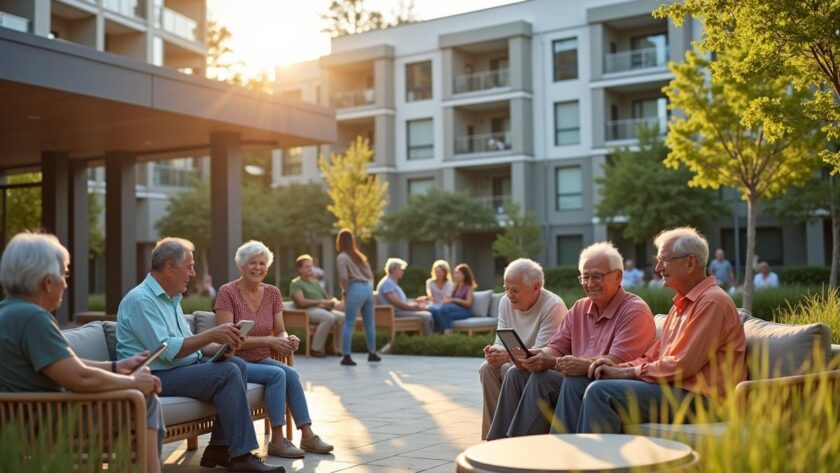Many people are rethinking expectations as senior living today evolves significantly. Gone are the days when older adults were automatically thought of as homebound or limited by outdated stereotypes. With more options available than ever, individuals can find the setting that suits their personalities, health needs, and social interests. This modern era of aging invites a richer conversation about freedom, possibility, and the wealth of experiences waiting around every corner.
Contents
Breaking Old Stereotypes About Aging
For too long, society has associated growing older with limitations, frailty, and minimal engagement in life. However, many seniors now redefine what it means to age gracefully by staying active, joining senior support groups, and exploring new hobbies. There is a growing awareness that older adults deserve respect and a thoughtful approach to senior care. More importantly, people are beginning to recognize the diverse forms of senior housing options, giving each person a better opportunity to decide what’s best for them.
Seniors today often embrace technology, whether by connecting with friends on social platforms or using handy apps for groceries and medical reminders. This trend helps dismantle tired labels and gives older adults a powerful sense of independence. Emailing grandkids, managing finances online, or even booking travel plans signals that these folks are just as curious and enthusiastic about life as anyone else. The shift in perspective transforms our understanding of retirement homes and senior living communities into environments of interaction, not isolation.
Finding the Right Fit: From Independent Living to Assisted Living
Choosing the right path can be both exciting and a little overwhelming. Some individuals lean toward independent living, where they can maintain a robust social life and handle daily tasks on their own. In these settings, residents enjoy on-site amenities that might include gardens, fitness areas, or even creative studios. At the same time, they have easy access to supportive services, just in case they need minor assistance or want home care services at some point down the line.
On the flip side, assisted living might be the perfect match for seniors who could use a helping hand with medication management or meal preparation. Assisted living facilities offer a caring team of trained professionals who support residents’ day-to-day activities without compromising their dignity. This model works particularly well for those who prefer close-knit communities, where staff are conveniently available to address any health or safety concerns. Whether you’re exploring options for yourself or a loved one, it’s clear that modern senior housing aims to offer different levels of care tailored to individual needs.
Balancing Comfort and Care
Within retirement communities, the balance between comfort and professional care becomes crucial. Many sites include memory care services or specialize in long-term care, catering to seniors with conditions like Alzheimer’s and dementia. Skilled nursing facilities may also operate nearby, ensuring that aging in place is possible should health needs become more complex. This means you can shift between levels of care in one location, a setup often known as continuing care retirement communities.
State-of-the-art geriatric care goes beyond simple supervision. It focuses on improving each individual’s quality of life, managing symptoms, and keeping track of any chronic conditions. Residents who thrive in these communities often cite easy access to medical help, rehabilitation services, and social programs as cornerstones of their success story. Add in the safety net of staff who watch for falls or other health risks, and you have a thorough approach to senior lifestyle comfort.
Encouraging Senior Wellness and Activities
Staying fit and engaged can significantly improve well-being. Senior wellness programs now go beyond the traditional exercise class, offering options like yoga, dance lessons, walking clubs, and group outings. This fresh mindset is especially common in active adult communities, where neighbors share activities that keep their minds and bodies in shape. Socializing with peers and tackling new challenges has been known to boost both mood and physical health, leading to a more fulfilling retirement.
Programs around senior activities might include nature hikes, volunteer opportunities, or skill-building workshops. Such events give retirees a reason to wake up excited and stay connected with others who share their passion for life. It’s a far cry from the old assumption that older adults prefer a quiet and passive lifestyle. By staying engaged, many find their golden years more enjoyable than ever.
Innovative Approaches to Leisure
Many retirement communities plan special events that welcome family members and friends, bridging generation gaps. Wine tastings, art exhibits, and outdoor movie nights often pop up on the calendar, creating a vibrant scene for seniors to continue lifelong hobbies or find new ones. Meanwhile, some communities collaborate with local organizations to sponsor charitable projects or community clean-ups, giving residents a sense of purpose.
Even memory care communities organize enriching activities tailored to specific cognitive needs. Gentle exercises, music therapy, and reminiscent discussions help spark cherished memories while providing a comforting sense of routine. These programs, run by professionally trained staff, reflect the overall shift from a one-size-fits-all senior care model to a holistic approach that prioritizes each person’s individuality.
Embracing Different Senior Housing Options
A wide variety of senior housing options now cater to personal tastes as well as health requirements. Active adult communities offer resort-style living for those who wish to maintain an energetic social life. If help with daily tasks becomes necessary, moving to assisted living facilities is a seamless transition that ensures consistent support. For those who prefer living at home, elder care services and home care services bring help right to the doorstep.
You might also find specialized services like palliative care or skilled nursing facilities for people with specific medical needs. Elders who want maximum flexibility can look into independent living communities that let them set their own routine but also provide backup support if it’s ever needed. Whatever the choice, it’s clear that these modern options aim to celebrate life without pressuring seniors into a particular mold.
Blending Tradition and Modernity
There has always been a heartfelt tradition of nursing homes, where round-the-clock care is available for those with significant mobility or health concerns. Modern nursing homes often combine tradition with the latest in medical technique, from cutting-edge rehabilitation services to high-quality dining options. Their locations can vary widely, ranging from countryside plots to condominium-style settings in urban areas.
Likewise, retirement homes and senior apartments continue to transform themselves to keep pace with the current generation’s preferences. Gone are the cramped rooms and lonely corridors; instead, many boast comfortable lounges, community gardens, and inviting décor that feels like home. Whether you’re downsizing for simplicity or seeking daily assistance, it’s never been easier to find the right blend of independence and care.
Aging in Place With Confidence
For those who wish to remain in their own homes, aging in place is an increasingly feasible option. Personalized senior care management services coordinate everything from home modifications and meal deliveries to nursing visits, ensuring safety and comfort. It allows individuals to maintain their routines, keep cherished possessions, and stay near familiar neighbors. The process can involve installing smart devices for medication reminders or scheduling regular check-ins from local health professionals.
Living arrangements like elderly housing or senior apartments sometimes also integrate aging in place solutions into their design. They feature grab bars in showers, broader doorways for wheelchairs, and emergency call systems. Such elements lighten the burden of daily chores and ensure senior safety. Many families feel relieved that their loved ones can stay at home longer, backed by reliable elder care services that blend seamlessly into daily life.
Community and Connections
Staying connected with friends, family, and the surrounding neighborhood remains an essential element of a fulfilling senior lifestyle. Informal gatherings, community dinners, and small clubs are an everyday highlight for many older adults who choose to remain at home. Even joining local senior support groups, whether online or in person, paves the way to companionship and emotional support.
Small gestures like neighbors chatting over the fence or grandchildren visiting every weekend bring familiarity and continuity. At the same time, advanced telehealth services now offer medical consultations online, reducing the need for arduous travel. Through these forward-looking approaches, aging in place can be a safe, rewarding experience that fosters meaningful interactions.
Looking Ahead to a New Era of Senior Living
The landscape of senior living communities has truly broadened, embracing more freedom and leaving stereotypes behind. Whether someone prefers a cozy apartment within continuing care retirement communities or a house filled with memories, there’s a setup available. By celebrating individuality, modern senior living empowers each person to live with dignity, purpose, and a spirit of adventure.
With a spectrum of options ranging from independent living accommodations that spark social engagement to assisted living that ensures everyday tasks are manageable retirees have the latitude to explore life on their own terms. Factor in quality medical support, senior wellness programs, and robust elder care services, and you’ll see why more people believe the best is yet to come. The key is recognizing that there is no one-size-fits-all solution and embracing the diversity that makes older adulthood such an enriching stage of life.




